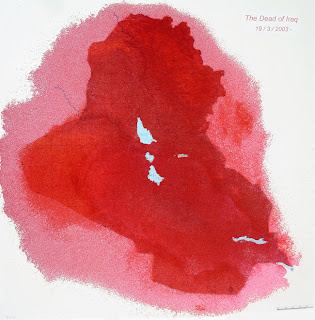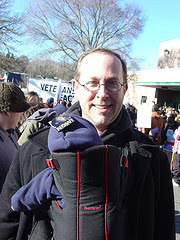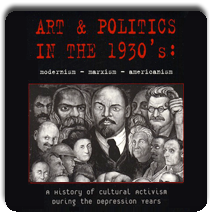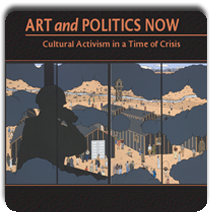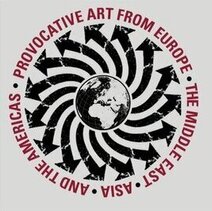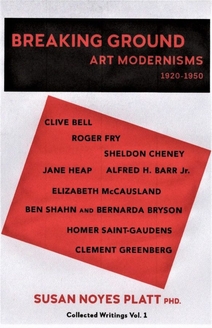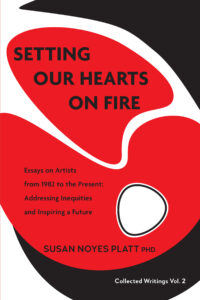A Valentine from New York Artists Against the War
 These two works stand in for any comment that I could make about the absurdity of Valentine’s Day and the marketing of romance in a time of war. Meanwhile people continue to die in Aghfanistan, Iraq, Gaza, the Sudan and Darfur as well as elsewhere.
These two works stand in for any comment that I could make about the absurdity of Valentine’s Day and the marketing of romance in a time of war. Meanwhile people continue to die in Aghfanistan, Iraq, Gaza, the Sudan and Darfur as well as elsewhere.
But the US election and the economy is all that appears in the newspaper. Narcissism is our main perspective and Valentine’s Day only reinforces the idea of emotions as commodities in our culture.
 New York Artists Against the War infiltrate a Nivea spring garden with a more important message, in the middle of Times Square.
New York Artists Against the War infiltrate a Nivea spring garden with a more important message, in the middle of Times Square.
This entry was posted on February 14, 2008 and is filed under Valentine New York Artists Against the War.
Valentine’s Day Joan Snyder Blood On Our Hands, USA, 2003
 Joan Snyder Blood on our Hands USA 2003 oil, acrylic, newspaper on board 16 x 16 “
Joan Snyder Blood on our Hands USA 2003 oil, acrylic, newspaper on board 16 x 16 “Joan Snyder includes a photograph taken in Baghdad shortly after the Shock and Awe campaign of a mother holding her wounded child
Here is another work by Joan Snyder, “Boy In Afghanistan”, 1988, 24″ x 30″) about a boy injured by land mines.

And a third below
Child, 1989, oil, acrylic, newspaper on linen, 8 x 12″ It makes a reference to children who are starving.

 This painting by Joan Snyder is called Modern Times, 2007. The image is full of agony and suffering. It reminds me of a late work by Arshile Gorky, with its elongated and disrupted lines and incomplete forms. The colors are oddly garish and pastel at the same time. There might be three main figures, and several smaller figures, bleeding, gaping, reduced to skeletal structures. The hollow eyes and mouths drip blood. Falling figures descend helplessly. To learn more about Snyder’s way of working go to this website
This painting by Joan Snyder is called Modern Times, 2007. The image is full of agony and suffering. It reminds me of a late work by Arshile Gorky, with its elongated and disrupted lines and incomplete forms. The colors are oddly garish and pastel at the same time. There might be three main figures, and several smaller figures, bleeding, gaping, reduced to skeletal structures. The hollow eyes and mouths drip blood. Falling figures descend helplessly. To learn more about Snyder’s way of working go to this website
Blood on our Hands USA connects in my mind directly to the iconic Code Pink action inside the Capitol building although it was painted several years before this confrontation at the Capitol building.

 “the blood of millions of Iraqis is on your hands” said the protestor to Condolezza Rice right before she and other courageous Code Pink members were forcibly dragged out of the hearing room by police as they shouted “war criminal”
“the blood of millions of Iraqis is on your hands” said the protestor to Condolezza Rice right before she and other courageous Code Pink members were forcibly dragged out of the hearing room by police as they shouted “war criminal”
Joan Snyder is right though, the blood is on OUR hands. It is our money and our government and our ridiculously passive Congress that is enabling the bloodshed.
This entry was posted on and is filed under Joan Snyder, Valentine Blood on our Hands.
The Breach: A play about New Orleans

This is Kara Walker’s August 27 2007 cover for the New Yorker, made one year after hurricane Katrina and the drowning of New Orleans. It refers to both the event itself, and its aftermath of false hopes, bungling, and outright racist greed for land ( via the tower in the distance) . It is called “Post Katrina Adrift”
Any art historian recognizes its source in Gericault’s Raft of the Medusa, another story of government incompetence that led to death by drowning.
It is fascinating to see how Walker has closely followed and adroitly altered the original.
In the Breach, by Catherine Filloux, Tarell Alvin McCraney & Joe Sutton, the central narrative of the play is based on three people on a roof top who have to fight with gravity in order not to drown, each of them falls into the water that surrounds them and is rescued, until the final concluding scene in which two are drowned. The parallel to the Raft of the Medusa is inescapable also in the play. There is also a baptism providing an ironic purifying with the polluted water that surrounds this family.
The narrative on this rooftop, between a grandfather and his teen age grandson and small granddaughter ( who speaks through her adult self), includes the psychodrama of any life threatening place, replaying small tensions and large anxieties, ranging through emotions from happy to heartbroken.
It is set in the midst of New Orleans, but it is a classic piece of theater that rises above that specific event to be almost Shakespearean in its characters. It resonates with THE flood of the bible, with Michelangelo’s Flood on the Sistine Ceiling, the story of Aeneas and Anchises, the elderly saved by the young.
Two other narratives, of an elderly alcoholic bar tender and a self proclaimed liberal reporter, who interact with the flood in other ways, one to confront his own death, the other to meet survivors who in their honesty and maturity confront the writer with his own limitations. He learns more about himself than about the disaster he is reporting. His only goal was to “expose the fiction” that the levees were deliberately breached. That pre planned agenda undid him when he was confronted with the realities of the people who had lived through this and other floods, the flood of life in general.
In the midst and moving through all of this is a figure of water, who shimmers and seduces all around her. Adding the mythical element reminded us that it was all a fiction, all a fragment of a much larger reality. Although the three playwrights continually spoke of “truth” as what they pursued, what they have really pursued is the reality that there is no truth, only human relationships.
Those human relationships of the play, today in the real world, continue to struggle against the larger forces which have now arrived to “rescue” them, by destroying their homes, and, as in so many cities, replacing low income housing with lucrative developments. The strong characters of New Orleans must continue to resist outsiders who threaten to inundate them, whether it is nature or the forces of capitalism.
The play’s use of water as a dominant mythic presence also reminded me of Kara Walker’s show at the Metropolitan Museum of Art in honor of Katrina. She also emphasized the role of water “the story of muck” as she put it, by including Copley’s Watson and the Shark an image of an almost drowning and Winslow Homer’s Gulf Stream, both paintings of survival in the midst of the dangers of water (in both these paintings actual sharks- in New Orleans human sharks are circling).

Athena Tacha’s Dead of Irak 1 drop = 1 dead
Dead of Irak, 2008
foamcore.
32 x 32 in.
Iraq map and glass microbeads 1/2 mm. diam. each (about 1 million)
Close up the separate small red shiny beads jump out at us, we can feel them physically on our skin, crawling on us, as a flow of blood, as a coming tide, it is our flow, the flow that is a tide of death, it comes from our bodies to the bodies of the Iraqis. It is covering the country except for a few small places. The blood as beads reminds us of the individual lives that are being destroyed paid for with our taxes, the blood as land reminds us of the land that we are poisoning
( as recently we dropped tons and tons of bombs on the orchards outside of Baghdad in order to “catch a terrorist cell”, one house I think was the target. The depleted uranium that poisons the blood of the future generations of Iraqis, the poison toxic fumes that we spread with our weapons.
foamcore.
32 x 32 in.
Iraq map and glass microbeads 1/2 mm. diam. each (about 1 million)
Close up the separate small red shiny beads jump out at us, we can feel them physically on our skin, crawling on us, as a flow of blood, as a coming tide, it is our flow, the flow that is a tide of death, it comes from our bodies to the bodies of the Iraqis. It is covering the country except for a few small places. The blood as beads reminds us of the individual lives that are being destroyed paid for with our taxes, the blood as land reminds us of the land that we are poisoning
( as recently we dropped tons and tons of bombs on the orchards outside of Baghdad in order to “catch a terrorist cell”, one house I think was the target. The depleted uranium that poisons the blood of the future generations of Iraqis, the poison toxic fumes that we spread with our weapons.
The artist Athena Tacha describes it as follows:
“It came out of my pain and sense of impotence for stopping the War. I had actually done in the past, on an off, political art (mostly activist about the environment), particularly during the Vietnam war On my website, look particularly at my Massacre Memorials (www.oberlin.edu/art/athena/tacha2.html#memorials) and its statement, but here is another statement I made recently in a feminist context:
“…deciding to make public art IS a political act in itself. In 1970, instead of becoming a volunteer nurse in Vietnam, I personally opted to bring my art into the public domain and make it accessible to all (not just to the intellectual elite who goes to museums, or to the rich who can buy it). As I stated in my interview with Landscape Architecture magazine (which published the first important article on my public art in May 1978), I wanted to “bring art into the lives of people and endow it with a social function” (such as creating sensitively designed plazas, recreation parks, riverbanks, etc.).”
In a way I consider the Dead of Irak a sequel to the my Massacre Memorials of the early 1980s .”
Ghiberti’s Gates of Paradise in Seattle
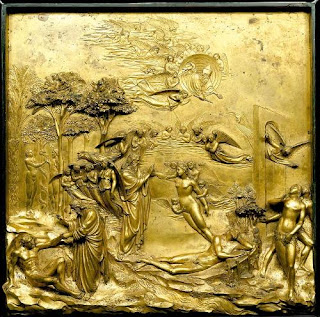
Images courtesy of Opera di Santa Maria del Fiore and Opificio delle Pietre Dure, Florence
Three panels are shining in the depths of the Seattle Art Museum, the Birth of Eve (bottom)
Saul and David (not pictured) and Jacob and Esau (top)
Their glowing gold surfaces have been restored by new technologies, this is the last time they will be seen outside of Italy. Some have been suspended in a chemical bath, others cleaned by lasers. The result is an entirely new experience of the doors.
We can see both the front and back, we see the detailed anatomy, complex spatial arrangements, sequential stories, landscapes, animals, birds, trees, hills, buildings, all in original new perspectives. Ghiberti found new ways of telling old stories and working with bronze. On the back we see the bronze with its undulations that mark the high and lower relief.
The ten panels of the Gates of Paradise were commissioned by the Guild of the Calimala with the support of the major merchants in Florence. Ghiberti’s salary was “equal to that of a manager of a Medici bank.” The cost of the panels was immense, tens of thousands of gold florins. They are the second set of doors created by Ghiberti for the Baptistery in Florence, and famous for the fact that he opened up the design into large squares of narrative.
The wealthy merchants of the community believed in commissioning modern art to call attention to their city. These gilded doors were the most sensational example of that idea. They are the same idea as Donald Trump gilding St. Gaudens 19th century statue of Sherman on horseback in the lavish 1980s. But the difference is telling. Trump is a contemporary merchant who used his personal fortune to restore a nineteenth century statue of a brutal military leader. In our country the government has little regard for contemporary artists, it does not fund individual artists anymore. The NEA actually was a funder for this exhibition of Renaissance art, the result of cultured business men from 500 years ago.
So what does Ghiberti show us?
no 9 Saul and David: David is killing Goliath by chopping off his head in the foreground, we forget that the famous sling shot didin’t actually kill Goliath, just stunned him. Ghiberti has pulled no punches in this gory scene.
This is the most Roman in style of the three scenes on display. Since the Romans were really good at invading other countries in rows of soldiers, it is a natural reference for this battle scene as well.
no.5 Jacob and Esau is the story of Betrayal, the story of the younger brother in cahoots with his mother stealing his brother’s blessing from his elederly blind father Isaac by wearing an animal skin that made him feel hairy like the older son Esau whom his father preferred.
no 1 The creation of Eve. The almost floating body of the nude Eve with a small angel pointing to her reproductive organs is the center piece of the story, the serpent is in the background, the creation of Adam, favored later by Michelangelo, is off to one side. It is the beautiful Eve, as predecessor to the virgin Mary who is celebrated here. But the next panel which didn’t come to Seattle shows the next stage of her life, her older son Cain, killing her younger son Abel: Fratricide.
Other scenes not included in Seattle are Noah’s Art, where the foreground image is Drunken Noah, rather than the orderly two by two parade that we are all used to, Sacrifice of Isaac,
(Abraham about to kill his own son),and Moses and the covenant. The story of Joseph is about betrayal, jealousy, and retribution.
(Abraham about to kill his own son),and Moses and the covenant. The story of Joseph is about betrayal, jealousy, and retribution.
Joshua is the story of the destruction of Jericho.
Lots of battles. lots of betrayals, lots of attacks on non Jews
The end is Solomon and Sheba, the peaceful coming together of Jews and Gentiles. The Queen of Sheba was from the lower Arabian peninsula. Solomon had 700 marriages, but this was apparently only a meeting of equals not a seduction.
Ghiberti begins with a celebration of Eve and ends with honoring the coming together of peoples who are different. He has overall a peaceful theme, in spite of all the betrayals, battles, and deceits.
Too bad, the Old Testament can’t be interpreted like that by everyone today, with the final message of peace .
This entry was posted on January 28, 2008 and is filed under Ghiberti's Gates of Paradise Israel Palestine.
Martin Luther King Day in Seattle!
This entry was posted on January 23, 2008 and is filed under Uncategorized.
War Made Easy How Presidents and Pundits Keep Spinning Us to Death
Last night I saw War Made Easy, an amazing film that traces the way war is constructed by Presidents in the same way over and over, putting over first lies, then drumbeats, “Peace” “Freedom” “Democracy” to make war, spread destruction, kill thousands.
In World War I ten percent of deaths were civilians. In the Iraq war ninety percent of deaths are civilians. The film used clips that dated all the way back to Roosevelt, and even World War I, but focused on the period from LBJ to GW Bush. There was even a transcript of Nixon talking about using nuclear weapons in Vietnam at the same time that he gave public speeches as a “man of peace.” The film laid bare the full extent of the campaign to disguise the death and destruction of war, to ignore the will of the people, to discredit opponents, to silence the perspectives of those being attacked.
Norman Solomon has analyzed the rhetoric of war from its initial promotion to the final withdrawal, and found astonishingly similar terms over the course of every war: contrived issues or provocations, Congressional resolution, ridicule of doubters, “support our troops”, admiration for military equipment by press,; then as the war drags on , escalation of the war, increased death justified for peace, and finally, the use of the meaningless term “quagmire”, and using nationals to kill each other, instead of US soldiers. And throughout the film, were pictures of people killed and terrified by actions on the ground that are the physical manifestation of this fabrication of of Peace, peace, peace, war for peace.
At the outset of World War II, there was Pearl Harbor, which FDR apparently knew was coming.
At the outset of the US war against Vietnam there was the Gulf of Tonkin incident, supposedly an attack from the North Vietnamese. It has been recently admitted to be a fraud. Congress authorized the war immediately.
Today we have some sort of incident in the Strait of Hormuz, well timed as Bush visits his Middle East. No identity was established for the small boats that approached the big aircraft carriers in a narrow strait, but we do know from experts that the “threats” recorded on a radio were not spoken by Iranian Farsi speakers.
And of course there was 9/11 that enabled the vague purposefully unending “war on terror”. Fitting it into this established narrative for war, it is a smooth example of a provocation which led immediately to the Congressional resolution, the drumbeat, the ridicule of doubters ( in this case firing journalists), the celebration of the military, the support our troops, and now we have gotten to the end of the narrative, the arming of nationals, in this case Iraqi Sunnis to kill other Iraqis, in addition to all the other arming of Iraqis we have pursued with police forces, etc.
IS the Strait of Hormuz the beginning of the next narrative, since the Weapons of mass destruction narrative has foundered?
The movie was narrated by Sean Pean. Anti war activist. Creative people making a difference.
This entry was posted on January 17, 2008 and is filed under "War Made Easy".
Robert Storr: Trapped in a Modernist Box
Throngs gathered on January 10 to hear Robert Storr, Dean of Yale Art School, last curator of the Venice Biennial, former curator of the Museum of Modern Art, speak at Kane Hall on the campus of the University of Washington.
He was talking about Kim Jones, whose work is on exhibition at the Henry Art Gallery until January 27. We heard only a little about Kim Jones though. We learned that he is “the only artist for whom war exists as a subject and an issue” according to Storr. That is the only artist in the “top ten” artists in Artforum. The clarification is necessary, because it tells you what perspective Storr comes from. He was speaking more about the “art scene” in New York and its obsession with prices and status, a topic which we in Seattle do not obsess about too much for a lot of reasons. It was helpful to us to be reminded of just how empty the “art scene” is though. Storr established himself as a man who is still embedded in the past by suggesting that the only other artists who currently address war are Raymond Pettibone and Jenny Holzer!
He owned up to painting abstract minimalist art himself. He quickly declared that Kim Jones, although he is the ONLY artist addressing war, was “not a political artist, he had nothing to preach, nothing to rebut”. These are very tired knee jerk disclaimers from modernists who fear above all else that artists might actually try to say something about the world.
And of course, to declare that Jones is the ONLY artist addressing war is completely absurd. His work is based, apparently, on the fact that during Vietnam, soldiers electrocuted rats, so he does a lot of rats. A type of PTSD played out with rats. His public performances “violate the code of good conduct on the street” according to Storr, although in the slide he showed no one was even noticing Jones in the New York subway, where there is, as far as I recall, NO code of good conduct.
Storr declared that Jones did a type of “war drawing” of mutual destruction, without actually explaining the game. The destruction is that he ERASES the drawing. Have we heard this somewhere before?
Could it be the famous erasure of the 1950s? The modernist narrative is that Rauschenberg erased a drawing by De Kooning in 1953 as a gesture of succession to the next generation of artists that rejected abstraction.
When Storr was asked if, given the need for artists to engage the world he was encouraging students to study Middle East history or other topics like that, he declared, yes of course, one elective is required at Yale.
ONE elective, no wonder the most promoted art in New York is so often self referential and vacuous.
According to Storr, Jones is “theatricalizing genuine alienation.” Well that sounds good, but if you parse those words they date back awhile. It is pure modernist argot. And individual artistic alienation is not the point today.
It is the US that is alienated today not the artist. The US is alienated from its stated principles, its supposed morals.
The day after Storr spoke, a demonstration addressed SIX YEARS of the illegal base at GUANTANAMO holding prisoners with no charges, no due process, no way of getting out. Amnesty International and World Can’t Wait called for its closure, as well as all sites of torture worldwide. There was a public performance that “violated the code of good conduct in the street” because it re enacted water boarding, the form of torture that involves simulated drowning by strapping a prisoner to a board and putting his head in a soaked towel ( see entry on Selma Waldman). We use it regularly on prisoners ( and have for many years trained others to practice it, dating back to Chile in the 1970s) .
Perhaps it would cheer up Robert Storr, who seemed to regret the emphasis on money and status in New York, to know that there are plenty of artists who discard their training to be greedy status seeking capitalists. They are choosing to speak about what is going on in the world. In fact, as an old modernist would say, “the good artists” are doing just that.
This entry was posted on January 15, 2008 and is filed under Robert Storr Modernism Guantanamo.
Deportations: Artists Can Make Visible the Invisible



Deportations are part of the US today. We think of the Nazis deporting Jews to concentration camp, we think of the US sending the Japanese to prison camps in World War II, but today, in partnership with the anti immigrant frenzy is the deportation frenzy.
Few artists have addressed this subject, other than Chicanos, whose families have long been divided by arbitrary laws.
Today, the numbers are huge.
230,000 immigrants including young children are detained each year.
ANYONE who is not a US citizen can be deported, including refugees, student visa and business visa holders. longtime legal residents with green cards convicted of a first time criminal offense.
In 1996 Congress changed immigration laws eliminating due process protections for immigrants who wanted to challenge their deportation.
Many are detained in centers that look like, smell like and feel like prisons. Sometimes they are jails.
After 9/11 there have been more and more detentions and deportations.
We have heard most about the “extraordinary renditions” and the illegal status of prisoners at Guantanamo. Artist Trevor Paglen and Journalist A.C. Thompson who wrote Torture Taxi, have written about and photographed some of these illegal sites in other countries by tracing secret airplane records.
Making visible the invisible.
In Afghanistan, the prison near Kabul that they identified is now being expanded to bring in the prisoners from Guantanamo. These are the “war on terror” detainees.
We hear very little about the hundreds of thousands of other detainees of all nationalities, held inside the United States awaiting deportation. They can be locked up indefinately. They have little medical care, poor food, no phones. They are moved frequently to prevent contact with families and lawyers.
This is the other side of the racist frenzy that has seized the US.
Families are ripped apart, people are unable to live their lives.
Making visible the invisible is something artists contribute to a political catastrophe- theyat least put it on the radar of the general public. That is the power of art, one image tells so much. Comparing the two images at the top of the page, the man with the image of his family speaks volumes, the signs with texts are helpful, but do not carry the same effect.
The statistics and information on deportation and detainees is from Hate Free Zone www.hatefreezone.org, Immigrant Justice Network www.immigrantjusticenetwork.org and Southeast Asia Resource Action Center www.searac.org
This entry was posted on January 8, 2008 and is filed under Deportations Torture Taxi.
SPARC Paint Down the Wall


These are a few details from a still unfinished mural in the parking lot of SPARC, The Social and Public Art Resource Center in Venice, California.
The project is called Paint Down the Wall. The mural is the work of a team of young muralists, some of whom have worked with SPARC for a number of years.
Their mural is protesting the building of the wall between Mexico and the United States as well as the brutal actions of vigilantes who stand at the border. The wall itself is only one physical manifestation of the anti immigrant frenzy that has spread across the USA. The absurd hypocrisy is that as anti immigrationists are shutting out people trying to make a living, the full enactment of NAFTA ( as of yesterday) will dump US subsidized cheap corn, beans, and sugar on Mexico, putting thousands of farmers out of business. There was a big protest yesterday in Mexico, reported here only on Free Speech Radio News
The mural shows Mexican immigrants at the border of all ages, men, women, grandmothers, children. They seem to have already been detained. At the center of the mural are turkey vultures, one of them grasping a bleeding calaveras ( skeleton). A captured family crouches under a tree, death as a calaveras lurking just behind them, while in the distance dark shadows of vigilantes threaten captured illegal immigrants with a whip and a dog.
At the other end of the mural a looming portrait of a Minuteman and other paramilitary types create a physical blockage of the space. A self styled vigilante with a blond goatee looks at the border with his huge binoculars. An elderly white man holds a sign” This land is my land, This land is not your land and it will never be.”
The yellow and black highway sign of a running family that warn drivers of immigrant families crossing the road now includes the words “stolen lands” in a reference to the fact that all of California, Arizona, New Mexico and part of Texas were declared part of the USA after the Mexican American war in 1848. All Chicano/as are historically Mexicans who ended up on the wrong side of the border. Only the lightest skinned former Mexicans were allowed to become US citizens.
Currently, SPARC is running a fund raising campaign to save the many murals in Los Angeles that are threatened or destroyed, or covered with graffiti . Attacks on the murals, like attacks on immigrants, are on the rise. Part of the reason is the government’s actions in shutting down creative outlets that provide opportunities for youth to express themselves constructively.
Go to their website to see more of their murals and donate to save the murals www.sparcmurals.org.
These murals are worth studying by anyone who wants to make a mural, a skill that is notably declining in our culture. Baca’s own roots are with David Alfaro Siqueiros as a muralist and she encourages others to follow in that grand and outspoken tradition that uses large scale figures and dramatic spatial relationships, as well as clearly written texts incorporated as signs, to make the mural speak out loudly and clearly. That is the crucial element, that we can understand what this mural is about without knowing anything. And we can be educated by it.
Here is SPARC’s statement about the PAINT DOWN THE WALL project. It is ongoing:
“When world events become so intolerable that you must take action, artists have the power of their brushes, spray cans, pens, cameras, to respond. We are asking those of you who object to the creation of a NEW BERLIN WALL on the border between the


